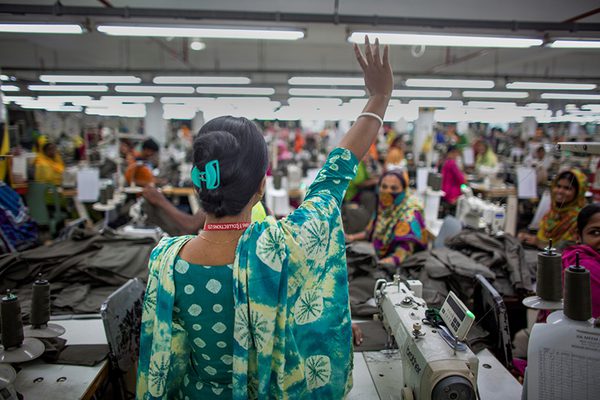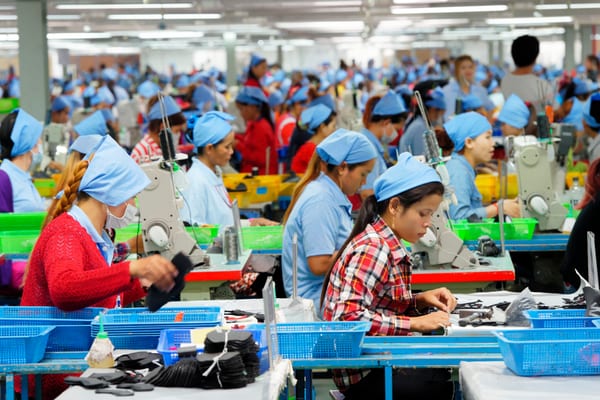Rana Plaza – Rebuilding more than the Factory
9 June 2014

Moves to protect workers since the Rana Plaza disaster are laudable but a more fundamental rethink of the market remains the only solution.
Over a year ago, 1,129 workers lost their lives and more than 2,500 were injured in a catastrophic industrial accident in Dhaka, Bangladesh. The accident was avoidable: Rana Plaza, the building in which dozens of factories operated, was an overcrowded structure where thousands of workers produced garments for major international brands servicing global markets.
The building collapsed even though workers had been warning about its structural integrity even on the day before the collapse. We now know that the building was insufficiently inspected and poorly administered, and factory managers keen to meet order deadlines chose to overlook workers’ concerns, and the building management couldn’t conceive that a solid building can collapse just like that.
We also know the statistics – that at the time of the accident, workers earned between $35 and $60 per month, and that a pair of jeans that cost less than $5 to produce would sell in global markets for $80 or more. The mark-up is hefty, but not unusual – in many industries, basic labour costs are often a small proportion of the price at which the product is sold.
In market-based economies, the wages are determined by the supply of labour (the more workers, the lower the wages), skills (higher the skill, higher the wages), and competition (the greater the likelihood of shifting operations elsewhere because of rising costs, the greater the pressure on the wages).
The comparison between what a garment worker earns in the US and in Bangladesh is instructive, but only up to a point. More relevant is an analysis of what goods and services a garment worker can buy with her wages in the US and in Bangladesh. Here, Bangladesh performs poorly – it is an inflation-prone economy, and the rising costs affect not only food and rent but also transport, and many workers travel long distances to the factories.
To be sure, there hasn’t been a catastrophic incident since the Rana Plaza disaster. Bangladesh is not the only country where industrial disasters, including fires, have occurred in recent years. Similar disasters have occurred in Cambodia and Pakistan. But a series of incidents have focused attention on Bangladesh. In the immediate aftermath, the Bangladesh government took important legislative steps, such as amending its 2006 Labour Act, which gave workers the right to form unions without seeking approval from their employers.
It is remarkable to think that workers had needed employers’ permission before organising themselves, but such was the situation. The gender dimension should not be forgotten: an overwhelming majority of Bangladeshi garment workers are women, and in a traditional, conservative society they are not empowered to be able to challenge their employers – often men – over wages or work conditions.
Small steps
There are commendable civil society initiatives in Bangladesh to empower the workers, and future efforts need to be focused in that direction. The government’s decision to increase the minimum wage is also a good step, but there is need for a complete cultural and attitudinal change.
This is because raising the wages – which should be done regardless of the state of Bangladesh’s factories – will not in itself solve the problem of the safety of structures. Recognising workers’ right to form unions will help. Unions are important not only to enable workers to bargain collectively but also to demand changes in the way their factories are run, including safety and security measures. And the recurring problem in Bangladesh has been that unions are not permitted, or when they are, they are part of the political apparatus, affiliated to political parties.
In itself that should not be a problem, except that in Bangladesh nearly a third of parliamentarians have a direct stake in the garment industry as investors or owners, and perhaps as many more are in some way dependent on the sector. This leads to “regulatory capture”, which means parliamentarians are loathe to do much that might increase costs – through higher wages, more inspections, or bigger fines for non-compliance.
The real problem in Bangladesh has been a culture of acceptance of inadequate building safety. A report in a Bangladeshi newspaper in 2013 said that fewer than 10 buildings in Dhaka – a city of 15 million people – had all the necessary approvals to be certified as safe. It is so notorious that a year earlier more than 100 workers had died in a fire at another factory. That was seen as a wake-up call, but there wasn’t much change; it took Rana Plaza’s collapse to inject a sense of urgency.
To address the problem and obvious reputational crisis, global apparel brands responded by forming two initiatives. Their aim: to require factories to establish proper procedures, based on mandatory, periodic inspections, so that such accidents do not happen again. While both initiatives – the Bangladesh Accord on Fire and Building Safety and the Alliance for Bangladesh Worker Safety – are well intentioned, there has been criticism of both.
They rely on audits and inspection as a way to enforce change. While auditing and measurement are valuable tools, they are not sufficient, and they often address the problem when it may be too late to resolve, leaving the foreign brand with limited alternatives. One option is to terminate the contract. And when that happens, the biggest losers are the poorly paid workers who lose jobs.
Conflict of interests
One reason reforms have been slow in Bangladesh is because many of the country’s factory owners are politicians themselves. This prevents adoption of progressive measures, since the parliamentarians/ businessmen have little incentive to increase costs – of inspections, wages, or fines – that businesses would have to bear.
This is not to suggest that the industry should abandon Bangladesh. Nobody should be calling for a boycott. Garments and textiles represent an important industry for Bangladesh that has created millions of jobs and earns Bangladesh significant hard currency revenues. Bangladesh now has economies of scale in the sector. But it poses risks, and it can no longer be business as usual, and companies – local and foreign – will have to raise their game significantly.
As the Centre for Business and Human Rights at New York University’s Stern School of Business lays out in a report released to coincide with the anniversary of the Rana Plaza disaster: “There are significant challenges to achieving the objective of a sustainable garment sector in Bangladesh. To date, too little attention has been paid to connecting the dots to provide an overall assessment of where things stand and what really needs to be done to ensure safer factories and better working conditions.”
The report focuses on an economic imperative that has a major impact on the issue – the way garments are sourced and the way prices are paid. It identifies the lack of transparency as adversely affecting good governance. “In the absence of an effective regulatory framework, the prevalence of indirect sourcing strategies has resulted in a supply chain driven by the pursuit of lowest nominal costs.”
As buyers drive down costs, the factories prefer to take higher risks rather than investing in safety. They also have an incentive to undermine wages and working conditions.
The two international initiatives – the accord and the alliance – have established “parallel, and in some cases overlapping” systems of monitoring and worker training, which contributes to confusion. According to Transparency International Bangladesh, the accord has produced 10 complete inspection reports so far, although it has visited some 80 factories in the past six months and recommended halting production in at least 10 factories. The process has been slow – given that Bangladesh has more than 5,000 factories, it will take decades before all factories are inspected at the current pace.
Wider problem
More importantly, the two programmes in fact cover fewer than 2,000 factories, since they target the companies that supply to international markets. Many of Bangladesh’s other 3,000 garment factories are smaller and probably operate in worse conditions. The accord and the alliance have neither the mandate, nor the incentive, to inspect or work with the bottom-tier factories.
Nor should they – this is the responsibility of the Bangladesh government, and surely the life of a worker in a toptier company is of the same value as the life of a worker manufacturing for the local market. Government inspectors are few, they remain poorly paid, and they have thousands of factories to inspect, creating perverse incentives of bribery to overlook infractions.
The Bangladesh government, whose job it is to regulate the industry, lacks the political will (partly due to the regulatory capture) and the ability (due to resource constraints) to fulfil its obligations. But many in Bangladesh question the apparent lack of resources. Bangladesh hosted an international cricket tournament recently which cost millions of dollars, and the government was able to find resources for that. Surely, these activists ask, it can find resources to protect workers’ lives?
While the international community has donated generously, as the NYU report points out, a major part of the funds support the International Labour Organisation and International Finance Corporation’s Better Work Programme.
Corruption is a major issue in Bangladesh, but by failing to create a way to channel resources where they are most needed, the international community runs the risk of circulating large amounts of money within itself – donors supporting international agencies that pay for foreign experts to audit and train local organisations, and international unions and civil society groups get funded to monitor or to participate in multistakeholder initiatives. Those are useful activities, but they do not build better-designed, safer buildings.
The responsibility to protect the human and labour rights of workers applies at many levels. It is critical for donor and importing governments to support locally led efforts to improve safety standards and provide incentives to local companies to adhere to international norms. International businesses must undertake due diligence to examine the capacity of their suppliers and train and provide resources so that they can improve their performance. Global trade unions should empower local counterparts to monitor local operations so they meet international safety standards. International civil society groups should encourage consumers to demand from their favourite brands that workers are treated fairly, have the right to bargain collectively and form unions, and receive fair living wages.
But Bangladesh also has to play its part. Its government will have to invest in inspecting and monitoring factories and regulate safety and security of the workforce, besides reforming laws that recognise workers’ rights. Local manufacturers will have to invest in improving factory infrastructure and pay fair living wages to their workers, and respect their right to form unions and bargain collectively. Local unions should focus primarily on the interests of workers and not on their own political affiliations, and local civil society groups should provide legal aid and support to workers, in particular women and migrant workers, so that their rights are protected.
This requires the industry to rethink how it procures garments from Bangladesh. It may mean paying a higher price to local suppliers, so that the local suppliers aren’t squeezed and are able to make the necessary investments. It may also mean that consumers in rich countries will have to start paying a more reasonable price for their T-shirts and jeans. Surely, as Henry Ford said about his auto workers’ salaries, garment factories want their workers to be able to afford the clothes they make. And they can do so, if they are paid more fairly.




